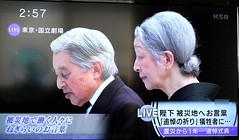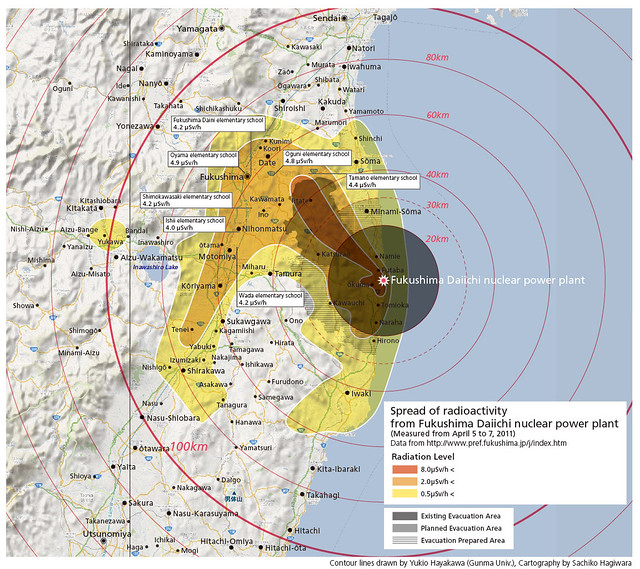 2011年3月11日,日本東北芮氏規模9.0大地震與大海嘯,造成16000人死亡,至今仍有3000人失蹤,更造成25年來最嚴重核電災變。一年後的這一天,日本人民在下午2:46分,也就是地震發生的同一時刻,默哀一分鐘。
2011年3月11日,日本東北芮氏規模9.0大地震與大海嘯,造成16000人死亡,至今仍有3000人失蹤,更造成25年來最嚴重核電災變。一年後的這一天,日本人民在下午2:46分,也就是地震發生的同一時刻,默哀一分鐘。
共有1200人參加311周年的追悼儀式,參加者包括日本明仁天皇、皇后美智子、首相野田佳彥與罹難者家屬。甫於2月29日動完心臟手術、現年78歲的明仁天皇對群眾演說時表示,為了提高防災意識、建構安全的國家,把經驗傳承給後代非常重要。
同時間,地震災害最嚴重的岩手縣、宮城縣與福島縣,也同步舉辦追悼會。宮城縣知事村井嘉浩與2500位民眾參與的儀式地點選在石卷市,這是單一城市受創最嚴重的地方,共有3182人死亡,553人失蹤。
 當時,地震海嘯接踵而至,東京電力公司所屬的福島第一核電廠喪失廠外電力,導致主要與備用冷卻系統雙雙失靈。儘管東電先灌注海水、而後再使用淡水加以冷卻,電廠核燃料仍然過熱,氫氣壓力持續累積而爆開,第一核電廠六座反應爐中有四座的廠房炸開,致使輻射隨著空氣擴散至遠處,也汙染土壤與海水。
當時,地震海嘯接踵而至,東京電力公司所屬的福島第一核電廠喪失廠外電力,導致主要與備用冷卻系統雙雙失靈。儘管東電先灌注海水、而後再使用淡水加以冷卻,電廠核燃料仍然過熱,氫氣壓力持續累積而爆開,第一核電廠六座反應爐中有四座的廠房炸開,致使輻射隨著空氣擴散至遠處,也汙染土壤與海水。
目前該電廠有兩座反應爐已停機維修,另四座則是自動關閉,但核燃料仍須持續加以冷卻,否則將熔毀而釋出輻射。
數個月內,官方一直未證實福島第一核電廠六座反應爐已有3座爐心熔毀;但是在2011年6月,核能管制官員表示,就在海嘯發生的隔天, 檢查員即發現碲-132,這是爐心熔毀的確切證據,卻對公眾隱瞞近3個月。
 日本電氣事業聯合會(FEPC)的報告指出,「4月27日,1號反應爐將近55%的燃料已經熔毀,2號機熔毀了35%,3號機則熔毀30%;而3號機與4號機的用過核燃料存放池則有過熱問題,恐怕也已受損。」
日本電氣事業聯合會(FEPC)的報告指出,「4月27日,1號反應爐將近55%的燃料已經熔毀,2號機熔毀了35%,3號機則熔毀30%;而3號機與4號機的用過核燃料存放池則有過熱問題,恐怕也已受損。」
日本政府已下令福島第一核電廠周圍30公里以內所有人員撤離,並開放學校與公有建築作避難所。在2011年9月,已有10萬多名福島縣居民撤離,被迫遠離自己家園和城市生活。到今年2月23日,尚有62674名福島居民有家歸不得。
在福島第一核電廠附近有些地方,年輻射量已累積達500毫西弗,居民返鄉的希望更加渺茫。
311東京追悼儀式上,首相野田佳彥表示,「我們仍盡可能支持受影響的區域,這些地方正試著恢復為更安全、更適合居住的家園。我們會盡最大努力復興福島,重建美麗家園。」
東電表示,截至目前為止,該公司已為核災受害者付出近4500億日幣的賠償金額。東電指出,目前只有40%符合資格的受害者領取補償金。倖存者抱怨,申請的程序緩慢又複雜,而東電又缺乏同情心 。
東京電力總裁西澤俊夫11日拜訪了核電廠,在下午2:46的追悼儀式中與200名員工會面。西澤表示「對所有死者與其摯愛的人們感到由衷的同情,我們的思念與祈求與他們同在,也與因為這一天悲慘事件而持續受苦的人們同在。」
西澤說,「我們隨時銘記在心,我們身負維持福島第一核電廠狀況穩定的重責大任。我們會持續維持安全,努力進行讓反應爐除役的中長期目標。」「此外,東京電力集團旗下所有公司,未來將進一步加強照顧受難者,讓他們更快取得補償。」
同一時間,世界各地也同步舉行追悼與祈福儀式。
在美國華府,美國總統歐巴馬表示「在日本這次結合大地震、海嘯與核子事故的重大不幸滿一周年之際,我與夫人,謹在此與美國人民一同追悼19000名蒙難者。看到日本人民以無比堅毅的態度面對如此難以想像的劇變,我們都深受鼓舞。他們的韌性與重建的決心,是我們所有人的典範。」
「災難發生的第一時間,美國即動員起來幫助日本友邦。我們組織『友達任務』(Operation Tomodachi),可說是美日兩國最大的單一軍事互助行動,在任務的最高峰,國防部派出24000人、190架戰機、24艘海軍艦艇支援人道與救災行動。災難一年後,我們仍願意協助日本人民重建。」
英國首相卡麥隆發表談話指出,「一年前日本遭受地震與海嘯的重創震驚了世人,我們看到日本民眾即使失去上萬同胞,目睹整社區消失,仍以無比的韌性面對劇變。」「一年後現在,日本民眾仍持續重建社區的勇氣與決心,艱鉅的重建工作並未難倒他們,令人敬佩。」
聯合國秘書長潘基文8日參加紐約一場日本駐聯合國代表處舉辦的紀念活動時表示,「就在幾天之前,聯合國專家報告了日本重建已有重大進展,光是在仙台市,他們每天處理460噸廢棄物。整個區域都在進行資源再利用,舊瓦礫成了新建築的材料。聽來振奮人心。」
國際原子能總署總幹事天野之彌在越南發表談話指出,國際社群已從這次意外中學得許多教訓,有助於核子安全更甚數年之前。「福島第一核電廠的事故非常嚴重,但我們已知道哪裡出了錯,讓日本乃至全世界都清楚該如何改正錯誤。」他表示,全世界的國家都在檢視核子安全系統中的漏洞,也正在採取補強措施。
Japan stopped for a moment on Sunday to mark the one-year anniversary of the earthquake and tsunami that leveled northeastern Honshu Island, left 16,000 people dead and 3,000 others missing, and precipitated the world's worst nuclear crisis in 25 years.
A moment of prayerful silence was held across the country at 2:46 pm, the precise time the 9.0 magnitude quake occurred off Japan's Pacific coast on March 11, 2011.
In Tokyo, about 1,200 people, including the Emperor and the Empress, Prime Minister Yoshihiko Noda and families of the victims, attended Sunday's ceremony.
Emperor Akihito, 78, who had heart surgery February 29, told the crowd that it is important to pass on the experience to future generations, to raise awareness of disaster prevention, and to build a safe country.
Memorial services also were held in the three prefectures hardest hit by the disaster - Iwate, Miyagi and Fukushima. About 2,500 people, including Miyagi Governor Yoshihiro Murai, gathered for a memorial in the city of Ishinomaki, Miyagi, which counted 3,182 dead and 553 others missing, the greatest number of casualties for a single municipality.
When the earthquake and tsunami struck, Tokyo Electric Power Company's Fukushima Daiichi nuclear power plant lost off-site power, throwing out its primary and backup cooling systems.
The nuclear fuel overheated despite company efforts to pump first seawater and then freshwater in to cool it. Hydrogen gas built up and exploded, blasting open four of the facility's six reactor buildings and spreading radiation far and wide in air, soil and seawater.
Two of the six reactors were already shut for maintenance. The other four shut down automatically as designed, but nuclear fuel requires continued cooling even after a plant is shut down or it melts down, releasing radiation..
Nuclear meltdowns at three of the six reactors at Fukushima Daiichi went officially unacknowledged for months. Nuclear regulators said in early June 2011 that inspectors had found tellurium 132, telltale evidence of reactor meltdowns, just a day after the tsunami but did not tell the public for nearly three months.
The Federation of Electric Power Companies of Japan reported, "...by April 27 approximately 55 percent of the fuel in reactor unit 1 had melted, along with 35 percent of the fuel in unit 2, and 30 percent of the fuel in unit 3; and overheated spent fuels in the storage pools of units 3 and 4 probably were also damaged."
The Japanese government ordered everyone within 30 kilometers of the damaged nuclear plant to evacuate and opened shelters for evacuees in schools and public buildings.
As of September 2011, more than 100,000 Fukushima Prefecture residents were still subject to evacuation measures that force them to live far from their home towns and cities.
As of February 23, there were 62,674 Fukushima residents who were still displaced from their homes.
Some places near Fukushima Daiichi are estimated to be contaminated with accumulated radiation doses of more than 500 millisieverts a year, lowering residents' hopes of returning there soon, if at all.
At today's memorial service in Tokyo, Prime Minister Noda said, "We will provide all possible support for the affected areas, which are now trying to revive their hometowns as safer and more livable towns. "We will do our best to revive Fukushima and recreate a beautiful hometown."
Tokyo Electric Power says that to date the company has paid nearly 450 billion yen, or about US$5.4 billion, to people harmed by the nuclear crisis.
Tokyo Electric Power Company, TEPCO, said only about 40 percent of those entitled to apply for compensation have done so. Survivors applying for benefits have said the process is too slow and complex and the company lacks compassion.
TEPCO President Toshio Nishizawa visited the plant on Sunday, where he joined about 200 employees in a moment of silence at 2:46 pm.
Nishizawa expressed "heartfelt sympathy to all those who passed away and their loved ones. Our thoughts and prayers are with them and also with those people who continue to be affected by the terrible events that unfolded on that tragic day," he said.
"While always keeping in mind the tremendous responsibility we have to maintain stable conditions at Fukushima Daiichi Nuclear Plant, we will continue to safely work towards the mid-to-long term decommissioning of the reactors," Nishizawa said. "In addition, all TEPCO group companies will further intensify their efforts to care for the presently afflicted and provide the compensation due them in a swift manner."
Memorial prayers and good wishes poured in from around the world.
In Washington, DC, President Barack Obama said, "As we mark one year since the catastrophic earthquake, tsunami, and nuclear disasters in Japan, Michelle and I join all Americans in honoring the memory of the 19,000 victims lost or missing. We continue to be inspired by the Japanese people, who faced unimaginable loss with extraordinary fortitude. Their resilience and determination to rebuild stronger than before is an example for us all."
"Since the first moments of the disaster, the United States mobilized to help our friends in Japan," President Obama said. "At the peak of Operation Tomodachi - our single, largest bilateral military operation with Japan ever - the Department of Defense had 24,000 personnel, 190 aircraft, and 24 Navy ships supporting humanitarian assistance and disaster relief efforts. One year later, we remain committed to assist the people of Japan to rebuild."
British Prime Minister David Cameron said, "A year ago we were all stunned to silence by the colossal devastation caused by the earthquake and tsunami in Japan. In the face of such tragedy, the Japanese people showed tremendous resilience as they came to terms with losing thousands of their countrymen, and witnessing entire communities being wiped out."
"Twelve months on and the Japanese people continue to sustain that courage and determination as they rebuild their communities, their homes and their lives," said Cameron. "And I greatly admire and respect the way they have overcome the enormous challenges of recovery."
UN Secretary-General Ban Ki-moon took part in an event in New York on Thursday evening, organized by the Japan's Permanent Mission to the UN to mark the one-year anniversary.
"Just a few days ago, UN experts reported that Japan is making enormous progress," Ban said. "In Sendai alone, they are processing 460 tons of waste every day. Across the region, they are recycling. Old debris is being used for new buildings. This is very heartening."
In Vienna, Director General of the International Atomic Energy Agency Yukiya Amano, who is Japanese, said the international community had learned many lessons from the accident, which has helped make nuclear safety stronger than it was a year ago.
"Fukshima Daiichi was a very serious accident, but we know what went wrong and we have a clear course of action to tackle those causes - not only in Japan but anywhere in the world," Amano said. He said that countries around the world are searching out weak links in their own nuclear safety systems and taking action to strengthen them.







